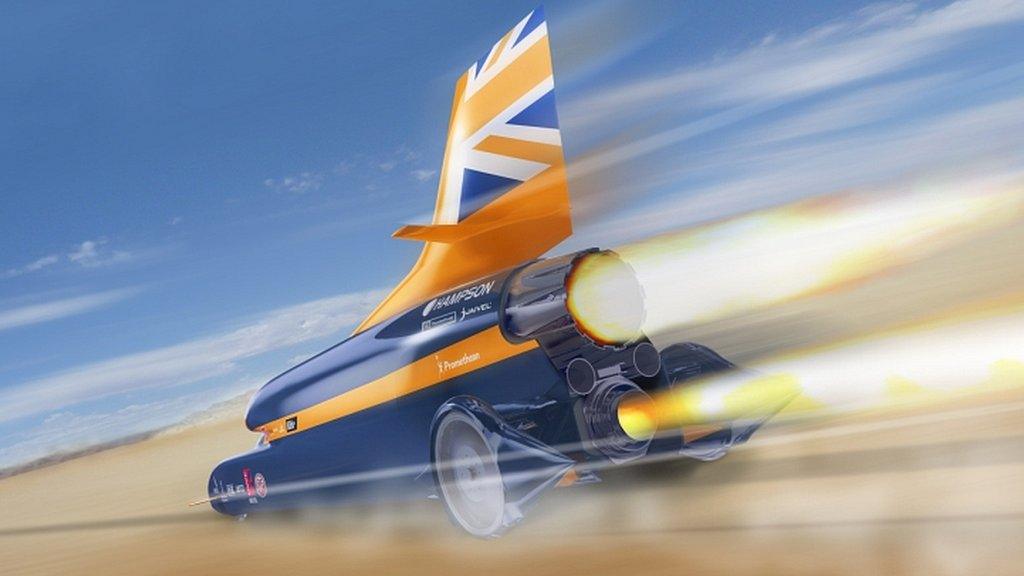Bloodhound rocket test signals coming land speed record reality
- Published
- comments
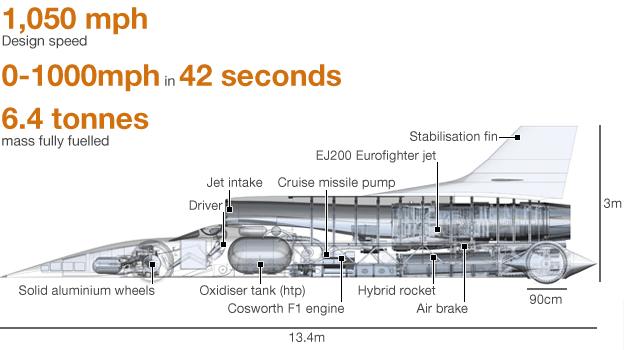
Image: Bloodhound SSC
Build it and they will come. The project to make a car capable of going 1,000mph (1,610km/h) is finalising the budget to complete its construction.
There then requires just the money to run it for at least two years - the time it will take first to breach the current land speed record (763mph or 1,228km/h), and thereafter to raise it beyond 1,000mph.
The thinking is that once people see the Bloodhound SuperSonic Car (SSC) for real, the sponsors necessary to complete the job will make themselves available. That's the idea, anyway.
For as long as Bloodhound remains just a "paper vehicle" (or the dream of a computer animator), there will inevitably be some hesitancy, some doubts... which makes this week's first UK firing of the car's hybrid rocket engine all the more important. It's a very visible demonstration of progress.
"We've been very good at being a virtual car, if you like," says chief engineer Mark Chapman.
"We rely very heavily on computational methods, computational design, and we do some great imagery. And people go, 'well, when's that going to happen?'
Mark Chapman: "We will be running next year in South Africa"
"But we're now in manufacture. So perhaps the biggest statement to make is [that] this is the rocket test fire, but this is also the first stage of a column of dominoes that will fall over the next six to 12 months, meaning this time next year we will be in South Africa running the car."
To recap for those who haven't been following this project that closely, Bloodhound is essentially the same team that claimed the land speed record for Britain in 1997.
Then, RAF fighter pilot Andy Green became the first driver to break the sound barrier in a car called Thrust SSC at Black Rock Desert in the US. The project was headed by Richard Noble, with Ron Ayers acting as the chief aero engineer.
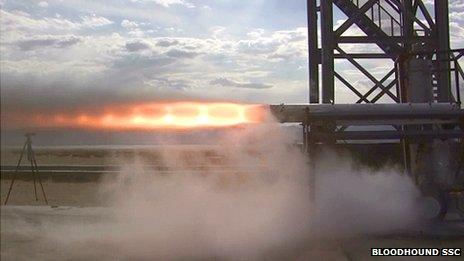
The 18in chamber has been fired before in the US, but the Newquay test will double the chamber pressure
All three are back in this new effort which was launched as an education initiative to spur children's interest in Stem subjects (science, technology, engineering and mathematics). To date, more than 5,000 schools are using the example of Bloodhound and the science of fast cars to enliven their classroom studies.
Quite a number of these children will be on hand at Newquay Cornwall Airport's Aerohub this Wednesday to witness the live firing of Bloodhound's 18in by 12ft (45cm by 3.6m) hybrid motor.
Bloodhound will use three engines to go 1,000mph. Its main power plants are a Eurofighter-Typhoon engine and the hybrid rocket. But the vehicle also incorporates a Cosworth F1 V8 engine as well. Remarkably, its role is "merely" to push a liquid oxidiser into the rocket's fuel chamber.
It will achieve this by driving a high-performance pump, which is actually an updated version of a unit that was used on the UK's old nuclear cruise missiles.
Engineers have the complex task of getting the rocket, the F1-CA2010 engine, and its missile pump to all work in perfect unison.
The Newquay test will be the first time the Bloodhound team has seen the trio and their control system run in anger. It's R&D in public.
Testing will be conducted inside a concrete-hardened hangar used in the past to house Tornado fighter-bombers.
The shelter was built to withstand attack by enemy bombers so if anything should go awry, the watching public - huddled in another Tornado shelter - should be perfectly safe.
Go faster
Britain was very much at the forefront of rocket development during the post-war years.
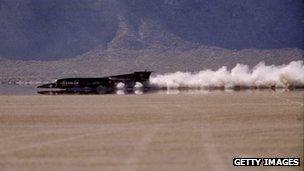
Thrust SSC in its 1997 land speed record run
The biggest system ever tested in the UK was the Blue Streak ICBM. This was done on a static test stand in Cumbria in the early 1970s (300,000lbf; 1,300kN).
More recently, in the 1980s, the Stonechat motors for the Falstaff research rocket were fired at Wescott in Buckinghamshire (60,000lbf; 270kN).
The Bloodhound hybrid is probably the most impressive since then.
"This rocket's designed to produce an average thrust of 25,000lbf, or 111kN, for 20 seconds; and that's what's required in conjunction with the jet engine to get Bloodhound to that 1,000mph," Daniel Jubb, the brains behind the power unit, told me.
"It actually needs to produce a peak thrust of 27,500lbf (122kN), and that peak thrust needs to be right at the end of the burn when the aerodynamic forces on the car, the drag, are at their highest.
"We're actually running at just over half-full chamber pressure on Wednesday, so because the nozzle is optimised for the full thrust firing, we're not going to see massively high levels of thrust, but we then have a series of development firings from later this year through to early spring in which we'll progressively increase the chamber pressure until we get the full performance."
In Wednesday's test, liquid oxidiser (high-test peroxide, or HTP) will be fed into the chamber at a pressure of 600psi (4MPa) to react with the solid fuel (hydroxyl-terminated polybutadiene, or HTPB). This should deliver an average thrust of 12,000-14,000lbf (50-60kN) with a peak somewhat over that. The burn will last 10 seconds.
Daniel Jubb: "It has exceptionally smooth burn characteristics"
Assuming all goes well, subsequent firings will eventually take the rocket up to its full performance.
As Daniel Jubb explained, a further four "R&D" burns should then prove the technical requirements of the rocket. There will also be an additional 10 "safety and acceptance" firings that will explore some of the rocket's limits, to certify the system for use in a manned vehicle.
All these firings are expected to take place in Newquay. Indeed, when the car does its first roll tests, it is likely to use the Aerohub runway, which means the Cornwall town is going to be an interesting place over the coming year.
It turns out that the full performance of the rocket is not needed to break the land speed record. The team plans to run it in a monopropellant mode only next year. In this configuration, the HTP is passed over a catalyst pack to decompose it into steam and oxygen, but instead of igniting a fuel grain, this superhot gas is allowed simply to vent through the chamber nozzle. This alone should produce 10,000lbf (45kN) of thrust, sufficient with the Eurofighter jet (20,000lbf/90kN) to take Bloodhound through the sound barrier to about 850mph.
Into the sky
All this has me wondering, though. What would happen if you pointed the car towards the sky. How high could it get?
"We've worked that out with some children in a school project," says Mark Chapman. "They were doing Newton's laws, F=ma. That kind of thing. With the full fuel burn onboard, Bloodhound got to 25,000ft and broke the sound barrier at about 17,000ft. It was a kid that asked that question. How high will it go? Fantastic."
Although, we should stress that a huge amount of design effort has gone into making sure this vehicle stays flat on the ground.
- Published23 September 2012
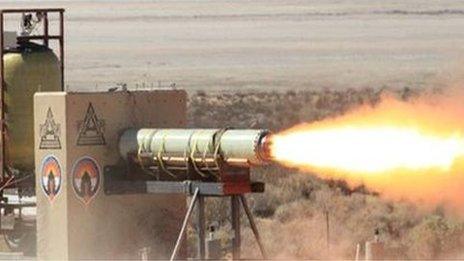
- Published12 September 2012
